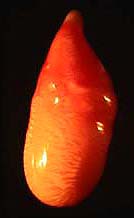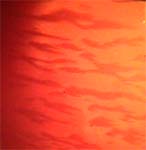A free gemology reference site
Gemology, gemstones, minerals and more
The Gemstones

Conch Pearl
Consumer Information
Above: Flame effect of conch pearl. All conch pearls courtesy of Sunlion Jewelers, Key West Florida.
What color is it?: Orange to red to yellow to anything in between as you see above.
What is the story behind this gemstone?: These are very, very rare pearls. Unlike their Japanese akoya cultured pearl counterparts, conch pearls are all natural. And it takes about 10,000 Queen Conchs to find one conch pearl. And only about 1 in 100 of those are gem quality as the one you see above. They are known by the flame structure that you see in the second photo. And they are very, very rare. And one more note: Key West, Florida is known as the Conch Republic. And if you go there be sure to pronounce the name like "conk" and not "conch." Not a bar in town will serve you if you don't say it right.
Can I wear it everyday?: Yes, but with care. They are like any other natural pearl you might own that is extremely rare, very expensive, and would be impossible to replace with one just like it if you wanted to. So use your own judgment.
Is it expensive?: Yes. Consider the numbers of Queen Conchs that have to get made into conch chowder to get even one gem quality pearl. Expect to pay dearly for a nice conch pearl of any size. And if you ever find a matched set for earrings they will be even more expensive.
Is it a birthstone?: No.
 What do I need to know before going shopping?: First, don't expect to find these pearls in the local Zales Jewelers in Racine, WI. They probably won't know what you are talking about (unless you turn them on to YourGemologist.com) There are only two places that I can tell you to find conch pearls: Key West and the Caribbean. And always look for the flame structure as outlined above. This is classic and diagnostic for conch pearls and will be the only gem on earth to show this effect.
What do I need to know before going shopping?: First, don't expect to find these pearls in the local Zales Jewelers in Racine, WI. They probably won't know what you are talking about (unless you turn them on to YourGemologist.com) There are only two places that I can tell you to find conch pearls: Key West and the Caribbean. And always look for the flame structure as outlined above. This is classic and diagnostic for conch pearls and will be the only gem on earth to show this effect.
...........
Another look at conch pearl flame structure up close
General Information
Source: Queen Conch living in Florida Straits, Bahamian and Caribbean Seas.
Chemical: Concretion of conchiolin
Formation: Organic
Crystal System: None
Unusual Properties: Flame structure shown above

